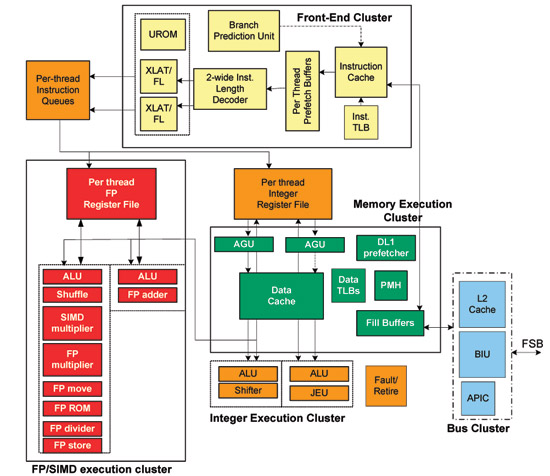NVIDIA Introduces dual Cortex A9 based Tegra 2
by Anand Lal Shimpi on January 7, 2010 2:00 PM EST- Posted in
- Smartphones
- Mobile
Atom vs. Cortex A9
With Atom Intel adopted an in-order architecture to save power. With Cortex A9, ARM went out of order to improve performance. Despite the fundamental difference, Atom and ARM's Cortex A9 appear similar from a high level.
Atom has two instruction decoders at the front end, as does the A9. The dual decoders feed an instruction queue that can dispatch out of order:

Intel's Atom Architecture
Both architectures appear to have a unified instruction queue that feed four dispatch ports. Atom has two ports that feed AGUs and/or ALUs, and two ports for the FPU (one for SSE and one for FP ops). A9 has two ALU ports, one FPU/NEON port and one AGU port.

Single-core ARM Cortex A9
Atom's advantage here is Hyper Threading as two threads get to share its execution resources simultaneously. Cortex A9's advantage is in a shallower pipeline and out of order execution. Both promote higher IPC but go about it in very different ways. If ARM can get clock speeds high enough they may actually have a higher performance option.
Final Words
Honestly, Tegra 2 is one of the most exciting things I've seen at CES - but it's mostly because of its dual Cortex A9 cores. While I'm excited about improving 3D graphics performance on tablets and smartphones, I believe general purpose performance needs improvement. ARM's Cortex A9 provides that improvement.
The days of me pestering smartphone vendors to drop ARM11 and embrace Cortex A8 are over. It's all about A9 now. NVIDIA delivers one solution with Tegra 2, but TI's OMAP 4 will also ship with a pair of A9s.
The big unknown continues to be actual, comparable power consumption. We're also lacking measurable graphics performance compared to the PowerVR SGX cores (particularly the SGX 540).
If NVIDIA is to be believed, then Tegra 2 is the SoC to get. I suspect that's being somewhat optimistic. But rest assured that if you're buying a smartphone in 2010, it's not Snapdragon that you want but something based on Cortex A9. NVIDIA is a viable option there and we'll have to wait until Mobile World Congress next month to see if there are any promising designs based on Tegra 2.
And just in case I wasn't clear earlier, we will see the first Tegra based Android phone in 2010. I just hope it's good.










55 Comments
View All Comments
prashy21 - Thursday, January 7, 2010 - link
Anand,Do you think this can be used in iSlate(Apple Tablet)..... ?
Doormat - Thursday, January 7, 2010 - link
Unlikely because Apple owns PA Semi and would presumably have them design the chip in the tablet. Plus there is the rumor that Apple and Nvidia don't get along after the whole GF 8000-series GPU problems. And Apple would have to rely on someone else's product cycle.So no. Its very unlikely. Which is unfortunate because the Tegra 2 would be a perfect fit for the Apple tablet - it has the audio and video toolkit, the dual ARM CPUs and a great GPU for OpenGL ES.
Griswold - Saturday, January 9, 2010 - link
"And Apple would have to rely on someone else's product cycle."You mean, just like they do with just about every other product they sell?
sviola - Friday, January 8, 2010 - link
But we might see this in MS Courier tablet (Afterall, they´re already a Nvidia partner).profquatermass - Sunday, August 15, 2010 - link
As an ageing Acorn Fanboy, It's nice to see the ARM chip finally starting to take over the computer world...You must be proud Sophie! :-)